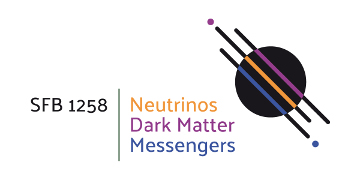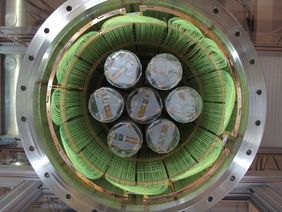While the Standard Model of Particle Physics has stood almost unchanged since its first conception in the 1960s, the experimental observations for neutrinos meanwhile proved that the neutrino part of the theory had to be completely reconsidered. The so-called neutrino oscillation was thereby the first observation not consistent with predictions of the Standard Model: The three known neutrino types can transform into each other while traveling through space - which proves that neutrinos have non-zero masses (Nobel Prize 2015), a property that contradicts the Standard Model.
Are neutrinos their own antiparticles?
Additionally, there is the longstanding conjecture that neutrinos are so-called Majorana particles: differing from all other constituents of matter like electrons or quarks they could be their own antiparticles. In this case, neutrinoless double beta decay will exist, in which matter is created without the balancing creation of antimatter. This imbalance would help to explain why there is so much more matter than antimatter in the Universe.
Prof. Stefan Schönert is head of the TUM team
The international GERDA experiment located in the Gran Sasso underground laboratory (LNGS) in Italy, is designed to scrutinize the Majorana hypothesis. In Germany, GERDA is supported by the Technical Universities of Munich and Dresden, the University of Tübingen and the Max Planck Institutes for Physics and Nuclear Physics. The TUM research group is led by the chair for Astroparticle Physics, Prof. Stefan Schönert.
Two neutrons decay in two protons at the same time
The GERDA team is searching for neutrinoless double beta decay of the germanium isotope 76Ge: two neutrons inside a 76Ge nucleus simultaneously transform into two protons with the emission of two electrons. This decay is forbidden in the Standard Model because the two normally produced antineutrinos - the balancing antimatter - are missing.
The GERDA experiment proves the highest sensitivity
The sensitivity to detect neutrinoless double beta decay largely depends on the level interfering signals from environmental radioactivity. The GERDA experiment has reached the lowest level of those by shielding with pure water and liquid argon and additional methods to reject the remaining interfering signals. It is now the first experiment that has surpassed a sensitivity for the half-life of the decay of 1026 years, or in other words, has proven that the process has a half-life of at least 1026 years, 16 orders of magnitude longer than the age of the universe. This half-life limit corresponds to a rate of less than 1 decay per 18 years for 1 kg of 76Ge.
The half-life corresponds to the neutrino mass
In the standard interpretation of neutrinoless double beta decay, the half-life is related to a special variant of the neutrino mass called the Majorana mass. Using the GERDA limit and the ones from other double beta decay experiments this mass has to be below 0.07 - 0.16 eV/c2 (1).
No tensions with other experiments
A limit on another variant of the neutrino mass is available from the Planck collaboration investigating the cosmic microwave background radiation - the relic of the big bang: the sum of the masses of all known neutrino types is below 0,12-0,66 eV/c2. The tritium decay experiment KATRIN at the Karlsruhe Institute of Technology (KIT) is measuring in the upcoming years yet another variant, the electron neutrino mass. KATRIN will reach a sensitivity of about 0,2 eV/c2. The masses deduced from these different investigations cannot be compared directly but, most interestingly, allow a cross checks of the paradigm that neutrinos are Majorana neutrinos. So far, no tension has been observed.
Increasing the detector mass and the sensitivity
During the reported data collection period, GERDA operated germanium detectors with a total mass of 35.6 kg. The fraction of the isotope 76Ge is enriched from the natural abundance of 7.8 % to more than 85 % to increase the half-life sensitivity.
As the next step, the mass will be increased and an even further reduction of interfering signals is required. The latter will be achieved by improving the identification of these signals and by further reducing the radioactivity of material close to the germanium detector.
From GERDA to LEGEND
To accomplish this goal, a new international collaboration, LEGEND, has formed whose spokesperson is Prof. Stefan Schönert from TUM. In 2018, Prof. Schönert has received an ERC advanced grant for the preparatory research work of the new major project. LEGEND will start with 200 kg 76Ge, initially using the existing GERDA infrastructure at LNGS. The sensitivity is planned to reach 1027 years after about five years starting in 2021.
GERDA is an international European collaboration of more than 100 physicists from Belgium, Germany, Italy, Russia, Poland, Switzerland (<link www.mpi-hd.mpg.de gerda>www.mpi-hd.mpg.de/gerda/home.html). In Germany, the experiment is financially supported by the German Federal Ministry of Education and Research (BMBF), the German Research Foundation (DFG) via the Excellence Cluster Universe and the SFB1258, and the Max Planck Society.
(1) 1 eV/c2(electron volts/square speed of light) is equal to 1,8 x 10-37kilogram
Original publication
The GERDA collaboration: <link https: science.sciencemag.org lookup doi science.aav8613 external-link-new-window internen link im aktuellen>"Probing Majorana neutrinos with double beta decay"
Science, published online on Thursday, 5 September 2019
<link https: science.sciencemag.org lookup doi science.aav8613 external-link-new-window internen link im aktuellen>DOI: 10.1126/science/ aav8613
Contact
Technical University of Munich
Prof. Stefan Schönert
Tel.: +49 89 289 12511
E-Mail: <link mail internen link im aktuellen>schoenert@ph.tum.de
Technical University of Dresden
Prof. Kai Zuber
Tel.: +49 351 463 42250
E-Mail: <link mail internen link im aktuellen>zuber@physik.tu-dresden.de
University of Tübingen
Prof. Josef Jochum
Tel.: +49 7071 297 4453
E-Mail: <link mail internen link im aktuellen>Josef.Jochum@uni-tuebingen.de
Max Planck Institute for Physics, Munich
Prof. Allen Caldwell
Tel.: +49 89 323 54207
E-Mail: <link mail internen link im aktuellen>caldwell@mpp.mpg.de
Max Planck Institute for Nuclear Physics, Heidelberg
Prof. Werner Hoffmann
Tel.: +49 6221 516 330
E-Mail: <link mail internen link im aktuellen>Werner.Hofmann@mpi-hd.mpg.de
Prof. Manfred Lindner
Tel.: +49 6221 516 800
E-Mail: <link mail internen link im aktuellen>lindner@mpi-hd.mpg.de
University of Zürich
Prof. Laura Baudis
Tel.: +41 44 635 5777
E-Mail: <link mail internen link im aktuellen>lbaudis@physik.uzh.ch



